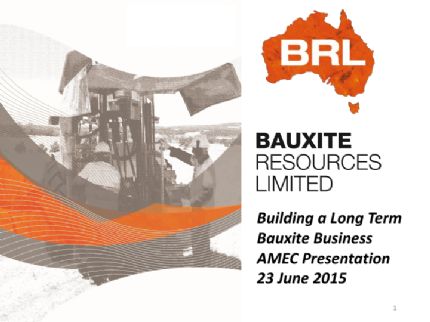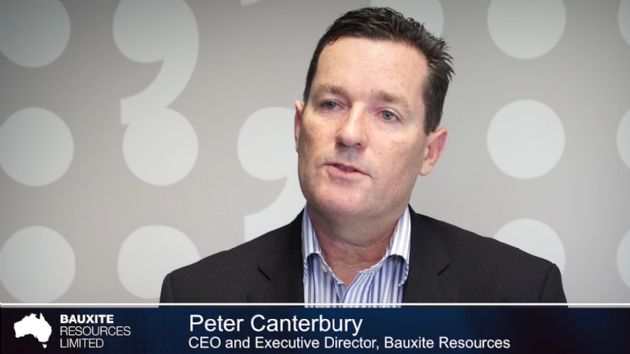 Bauxite Resources Limited (ASX:BAU) And Yankuang Corporation To Sign Agreement For Future Modern Alumina Refinery
Bauxite Resources Limited (ASX:BAU) And Yankuang Corporation To Sign Agreement For Future Modern Alumina Refinery
Perth, Sep 23, 2010 AEST (ABN Newswire) - Australian resources company Bauxite Resources Limited ( ASX:BAU) (
ASX:BAU) ( PINK:BXRDF) ("BRL" or "the Company") is pleased to announce that it will enter into a further Heads of Agreement with its long term Chinese partner, Yankuang Corporation ("Yankuang"), to complete a bankable feasibility study for the design and construction of a modern refinery in the southwest of Western Australia to refine Darling Range bauxite into alumina. The further Heads of Agreement requires shareholder and regulatory approval.
PINK:BXRDF) ("BRL" or "the Company") is pleased to announce that it will enter into a further Heads of Agreement with its long term Chinese partner, Yankuang Corporation ("Yankuang"), to complete a bankable feasibility study for the design and construction of a modern refinery in the southwest of Western Australia to refine Darling Range bauxite into alumina. The further Heads of Agreement requires shareholder and regulatory approval.
The refinery approximate design capacity will be 1.1 million tonnes per annum (mtpa) of alumina which will require approximately 3.5mtpa of bauxite. BRL and Yankuang propose that construction will be commenced within 5 years subject to a bankable feasibility study, site selection, environmental and regulatory approvals.
Under the terms of the binding heads of agreement, Yankuang has agreed to fund 91% of the refinery's construction costs in return for receipt of 70% of the alumina product, with BRL owning / receiving rights to the remaining 30% of alumina.
BRL will pay for the remaining 9% of construction costs and will receive assistance from Yankuang to arrange financing. Yankuang will also off-take half of BRL's share of alumina production upon terms to be agreed.
Bauxite Resources Limited Chairman and acting CEO, Barry Carbon, said, "We believe this agreement represents a positive opportunity to deliver long term shareholder value by securing finance with our Chinese strategic partner, Yankuang, for a major infrastructure and bauxite resource development project. Yankuang has the experience and technology to ensure a state of the art alumina refinery in the southwest which will secure long term employment for the region and ensure Western Australia's future as an alumina producer."
Under the agreement, Yankuang becomes eligible for 70% of BRL's Darling Range bauxite rights (except for 1000km2 of BRL Tenements in the Shandong No.1 Institute agreement). Any direct use of bauxite for non-refining purposes that is commenced within 3 years will have an allocation split of 51% to BRL and 49% to Yankuang.
In addition, Yankuang has agreed to refund to BRL 70% of previous tenement / exploration costs. Yankuang will also contribute 70% to the cost of future tenement / exploration costs. Should refinery construction not commence within 5 years, BRL will have the option to acquire back 21% of the bauxite rights at that time to restore BRL 51% and Yankuang 49% ownership. This option will be at cost plus 15% incurred by Yankuang in respect of that 21% interest.
A bankable feasibility study will also be carried out alongside the strategy to design and build the alumina refinery. It is now proposed that leading design agencies and consultancies based in China and Australia will be utilised for the bankable feasibility study. This bankable feasibility study will require all the necessary approval processes with Yankuang contributing 90% to the cost and BRL contributing 10%.
The further Heads of Agreement will lead to a substantial reduction in operating costs for BRL which will ensure that it has sufficient cash reserves over the medium term.
A site has yet to be determined for the alumina refinery, although BRL and Yankuang intend to work closely with the government agencies and other key groups to identify a suitable location for the site. This decision will be based on stringent environmental conditions and close consultation with local communities.
BRL has commenced a new program of bauxite exploration with its Chinese partner, Shandong No.1 Institute, in which the first exploration program represents 1000km2 of BRL tenements. Shandong No.1 Institute has agreed to pay all tenement and exploration costs while BRL has purchased an appropriate drill rig with a contract in place for drilling during 2010/11. If the exploration program and BFS result in a mining operation, BRL and Shandong No.1 Institute have agreed to allocate the costs and benefits 40:60, respectively. Both BRL and Shandong No.1 Institute are also discussing exploration of other minerals across BRL's entire Darling Range Tenements.
Barry Carbon added, "We are delighted that both Yankuang and Shandong No.1 Institute have agreed to partner us in Western Australia as we strive towards achieving our aspirations of becoming a long term producer of bauxite and alumina."
The updated strategy for BRL is a response to market conditions. BRL will submit a formal proposal for shareholders to approve the further Heads of Agreement with Yankuang at its planned Annual General Meeting (AGM) on Thursday 25 November, 2010. Full details of the further Heads of Agreement will be provided to shareholders in a formal notice of the AGM to shareholders.
Yankuang Corporation in Brief
Established in 1976, Yankuang Corporation is a Chinese state-owned conglomerate with coal mining, coal-based chemicals, machinery manufacturing, electricity generation and aluminium as its main businesses.
Yankuang has total assets of 100 billion RMB (around AU$16.6 billion). It owns or has controlling stakes in 37 subsidiaries with a staff of 93,000. Its Coal Mining Company (Yan Coal ( SHA:600188) (
SHA:600188) ( NYSE:YZC) (
NYSE:YZC) ( HKG:1171)) is listed on New York, Hong Kong and Shanghai as of 1998. The annual output of coal is about 40 million tons.
HKG:1171)) is listed on New York, Hong Kong and Shanghai as of 1998. The annual output of coal is about 40 million tons.
The Electricity & Aluminium Company has 9 peat coal and coal-gangue fired power stations with a total installed generation capacity of 527MW and has thus established itself as the biggest power producer of its kind in China.
The smelter has an annual production capacity of 140,000 tons of aluminium and 100,000 tons of baked anode for aluminium purpose. A large aluminium extrusion project with the world largest (150MN) double-action forward extrusion press is under construction. Upon completion in May 2011, the fabrication plant is set to extrude 133,000 tons of aluminium and cast 14,500 tons of ingot. The finished products include high performance heavy section material for train carriage and high performance tubes and bars for other industrial uses.
Shandong No.1 Institute of Geology & Minerals Exploration in Brief
Shandong No.1 Institute of Geology & Minerals Exploration (NO.1 Institute) is an integrated geological exploration entity with the scope of business as follows:
- geological prospecting
- mining
- engineering geophysical exploration
- agricultural geology
- disaster-related Geology
- hydrogeology survey
- geothermal prospecting and development
- marine geological survey
- marine surveying,
- geotechnical construction,
- engineering mapping
- map making
- publishing and printing
- geological drilling machine Market
- laboratory analysis of samples
- vehicle driver training
As one of the 13 institutes under management of SDMG, No.1 Institute is the biggest of its kind with a staff of some 1100, among which are 180 senior engineers and 36 senior research fellows. Since its inception, the institute has prepared some 1200 reports detailing the resources identified through their work over years:
- Iron ore: 376 million tonnes
- Coal: 78.4 billion tonnes
- Gypsum: 38.17 billion tonnes
- Halite: 7.521 billion tonnes
- Limestone: 900 million tonnes
In addition, No. 1 Institute has conducted geological survey and mapping for over 90% of the ropeway projects in the mountainous areas in China and for 7 major airports in east China. Also, thanks to its experience in marine survey, it has undertaken the overall technical support to the country's first offshore coal project.
About Bauxite Resources Limited
 Bauxite Resources (ASX:BAU) (OTCMKTS:BXRDF) was established with a substantial tenement holding in Western Australia to develop new bauxite supply for the global alumina/aluminium industry. The Company listed on the Australian Securities Exchange (ASX) in October 2007.
Bauxite Resources (ASX:BAU) (OTCMKTS:BXRDF) was established with a substantial tenement holding in Western Australia to develop new bauxite supply for the global alumina/aluminium industry. The Company listed on the Australian Securities Exchange (ASX) in October 2007.
The Darling Range in the south-west of Western Australia (WA) is the world's largest bauxite mining and alumina refining region producing around 20% of the world's alumina. This area has mined bauxite and refined alumina since the 1960s. These industries are leaders in sustainable resource development and represent the fifth largest sector of WA's resource industry.
![abnnewswire.com]()
Related Companies
Social Media
Share this Article

 ASX:BAU) (
ASX:BAU) ( PINK:BXRDF) ("BRL" or "the Company") is pleased to announce that it will enter into a further Heads of Agreement with its long term Chinese partner, Yankuang Corporation ("Yankuang"), to complete a bankable feasibility study for the design and construction of a modern refinery in the southwest of Western Australia to refine Darling Range bauxite into alumina. The further Heads of Agreement requires shareholder and regulatory approval.
PINK:BXRDF) ("BRL" or "the Company") is pleased to announce that it will enter into a further Heads of Agreement with its long term Chinese partner, Yankuang Corporation ("Yankuang"), to complete a bankable feasibility study for the design and construction of a modern refinery in the southwest of Western Australia to refine Darling Range bauxite into alumina. The further Heads of Agreement requires shareholder and regulatory approval. SHA:600188) (
SHA:600188) ( NYSE:YZC) (
NYSE:YZC) ( HKG:1171)) is listed on New York, Hong Kong and Shanghai as of 1998. The annual output of coal is about 40 million tons.
HKG:1171)) is listed on New York, Hong Kong and Shanghai as of 1998. The annual output of coal is about 40 million tons. Bauxite Resources (ASX:BAU) (OTCMKTS:BXRDF) was established with a substantial tenement holding in Western Australia to develop new bauxite supply for the global alumina/aluminium industry. The Company listed on the Australian Securities Exchange (ASX) in October 2007.
Bauxite Resources (ASX:BAU) (OTCMKTS:BXRDF) was established with a substantial tenement holding in Western Australia to develop new bauxite supply for the global alumina/aluminium industry. The Company listed on the Australian Securities Exchange (ASX) in October 2007.












